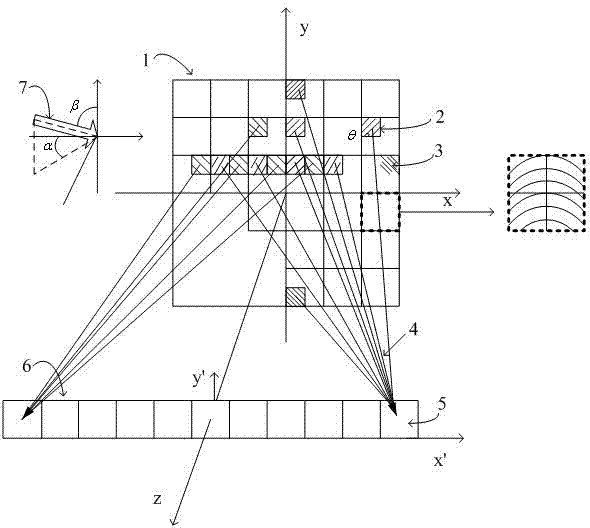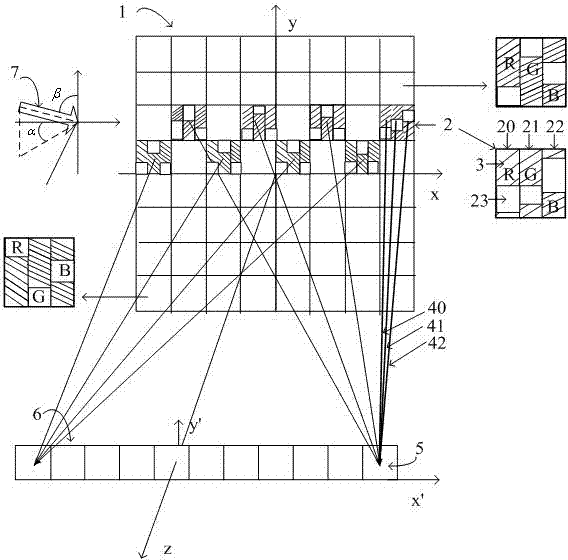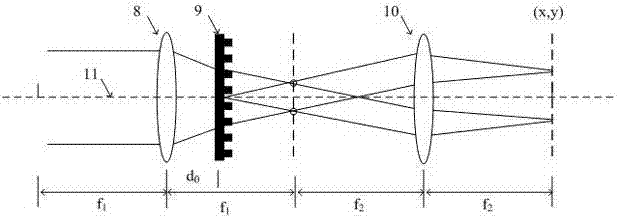3D laser printing method and system
A 3D laser and printing system technology, applied in the direction of optics, optical components, diffraction gratings, etc., can solve the problems of complex mechanical movement mechanism, unfavorable optical path stability, etc., and achieve simple system structure, good printing and imaging effect, and strong stereoscopic effect of 3D images Effect
- Summary
- Abstract
- Description
- Claims
- Application Information
AI Technical Summary
Problems solved by technology
Method used
Image
Examples
Embodiment 1
[0040] See attached figure 1 , is a schematic diagram of a four-parameter (x, y, Λ, θ) three-dimensional image with continuously variable grating space frequency and orientation and its display effect in this embodiment.
[0041] The three-dimensional image 1 of this embodiment is located at the coordinate plane (x, y), and is composed of a series of diffractive pixels 2 filled by a group of pixel gratings 3 with specific space frequency and orientation. The space frequency of the pixel grating in the image 1 changes gradually from top to bottom, depending on the direction of the illumination light and the position of the observation window. Generally, the space frequency gradually increases from the top to the bottom of the image. The three-dimensional image is diffracted under the illumination of the illumination light 7, and a slit-shaped observation window 6 is formed on the (x', y') plane at a distance from the image plane Z, and the observation window 6 is composed of a ...
Embodiment 2
[0049] See attached figure 2 , is a schematic diagram of a four-parameter (x, y, Λ, θ) three-dimensional color image with continuously variable grating space frequency and orientation in this embodiment.
[0050] The three-dimensional color image 1 of this embodiment is located at the coordinate plane (x, y), and is composed of a series of diffraction pixels 2, and the diffraction pixels 2 are composed of red sub-pixels 20, green sub-pixels 21, and blue sub-pixels 22, so The sub-pixels of the above three colors are filled by a group of gratings 3 and blank areas 23 with specific space frequencies and orientations. The space frequency of the pixel grating in image 1 changes gradually from top to bottom, depending on the direction of the illumination light and the position of the observation window. Generally, the space frequency gradually increases from the top to the bottom of the image. The three-dimensional color image is diffracted under the illumination of the illuminati...
Embodiment 3
[0054] see image 3 Shown is a schematic diagram of a four-parameter (x, y, Λ, θ) optical modulation method with continuously variable grating space frequency and orientation.
[0055] In this embodiment, a four-parameter (x, y, Λ, θ) optical modulation method with continuously variable grating space frequency and orientation. including focal length f 1 The first Fourier transform lens 8 with focal length f 2 The 4F optical system and the diffraction grating 9 are constituted by the second Fourier transform lens 10 lenses. The diffraction grating 9 is located between the first Fourier transform lens and the focal length of the first Fourier transform lens. The diffraction grating can move along the optical axis 11 or rotate around the optical axis 11 .
[0056] The method changes the distance d between the diffraction grating and the first Fourier transform lens by moving the diffraction grating 9 0 , realizing the continuous modulation of the grating space frequency Λ pa...
PUM
 Login to View More
Login to View More Abstract
Description
Claims
Application Information
 Login to View More
Login to View More - R&D
- Intellectual Property
- Life Sciences
- Materials
- Tech Scout
- Unparalleled Data Quality
- Higher Quality Content
- 60% Fewer Hallucinations
Browse by: Latest US Patents, China's latest patents, Technical Efficacy Thesaurus, Application Domain, Technology Topic, Popular Technical Reports.
© 2025 PatSnap. All rights reserved.Legal|Privacy policy|Modern Slavery Act Transparency Statement|Sitemap|About US| Contact US: help@patsnap.com



